| # | Name | Photo | Date of rank [1] | Position | Yrs [3] | Commission [4] | YC [5] | Notes |
|---|
| 1 | Alexander A. Vandegrift |  | 21 Mar 1945 | | 2 | 1909 (OCS) | 36 | (1887–1973) Awarded Medal of Honor, 1942. |
| * | Roy S. Geiger | 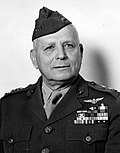 | 23 Jan 1947 | | 0 | 1909 (OCS) | 38 | (1885–1947) [7] |
| 2 | Clifton B. Cates | 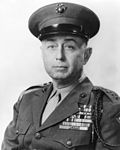 | 1 Jan 1948 | | 4 | 1917 (OCS) | 31 | (1893–1970) [8] |
| 3 | Lemuel C. Shepherd Jr. |  | 1 Jan 1952 | | 7 | 1917 (VMI) | 35 | (1896–1990) [9] |
| 4 | Randolph M. Pate |  | 1 Jan 1956 | | 4 | 1921 (VMI) | 35 | (1898–1961) |
| 5 | David M. Shoup |  | 1 Jan 1960 | | 4 | 1926 (ROTC) | 34 | (1904–1983) Awarded Medal of Honor, 1943. |
| 6 | Wallace M. Greene Jr. | 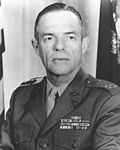 | 1 Jan 1964 | | 4 | 1930 (USNA) | 34 | (1907–2003) |
| 7 | Leonard F. Chapman Jr. |  | 1 Jan 1968 | | 4 | 1935 (NROTC) | 33 | (1913–2000) U.S. Commissioner of Immigration and Naturalization, 1973–1977. |
| 8 | Lewis W. Walt | 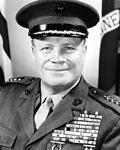 | 2 Jun 1969 | | 2 | 1936 (ROTC) | 33 | (1913–1989) |
| 9 | Raymond G. Davis |  | 12 Mar 1971 | | 1 | 1938 (ROTC) | 33 | (1915–2003) Awarded Medal of Honor, 1950. |
| 10 | Keith B. McCutcheon |  | 1 Jul 1971 | | 0 | 1937 (ROTC) | 34 | (1915–1971) [10] |
| 11 | Robert E. Cushman Jr. |  | 1 Jan 1972 | | 4 | 1935 (USNA) | 37 | (1914–1985) Deputy Director of Central Intelligence, 1969–1971. |
| 12 | Earl E. Anderson |  | 31 Mar 1972 | | 3 | 1940 (NROTC) | 32 | (1919–2015) |
| 13 | Louis H. Wilson Jr. | 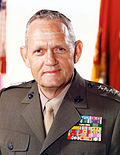 | 1 Jul 1975 | | 4 | 1941 (OCS) | 34 | (1920–2005) Awarded Medal of Honor, 1944. |
| 14 | Samuel Jaskilka | 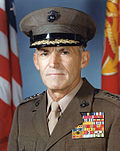 | 4 Mar 1976 | | 3 | 1942 (OCS) | 34 | (1919–2012) |
| 15 | Robert H. Barrow |  | 1 Jul 1978 | | 5 | 1942 (OCS) | 36 | (1922–2008) |
| 16 | Kenneth McLennan |  | 2 Jul 1979 | | 3 | 1945 (OCS) | 34 | (1925–2005) |
| 17 | Paul X. Kelley |  | 1 Jul 1981 | | 6 | 1950 (NROTC) | 31 | (1928–2019) Chairman, American Battle Monuments Commission, 1991–1994, 2001–2005. |
| 18 | John K. Davis |  | 1 Jul 1983 | | 3 | 1950 (NROTC) | 33 | (1927–2019) |
| 19 | George B. Crist |  | 22 Nov 1985 | | 3 | 1952 (NROTC) | 33 | (1931–2024) |
| 20 | Thomas R. Morgan |  | 1 Jun 1986 | | 2 | 1952 (NROTC) | 34 | (1930–2024) |
| 21 | Alfred M. Gray Jr. |  | 1 Jul 1987 | | 4 | 1952 (OCS) | 35 | (1928–2024) |
| 22 | Joseph J. Went |  | 1 Jul 1988 | | 2 | 1952 (NROTC) | 36 | (1930– ) |
| 23 | John R. Dailey | 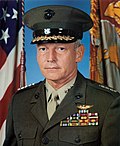 | 1 Aug 1990 | | 3 | 1956 (NROTC) | 34 | (1934– ) Associate Deputy Administrator, National Aeronautics and Space Administration, 1992–1999; Director, National Air and Space Museum, 2000–2018. |
| 24 | Carl E. Mundy Jr. |  | 1 Jul 1991 | | 4 | 1957 (NROTC) | 34 | (1935–2014) President, United Service Organizations, 1996–2000. |
| 25 | Joseph P. Hoar | 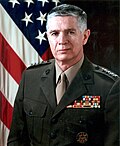 | 1 Sep 1991 | | 3 | 1957 (NROTC) | 34 | (1934–2022) |
| 26 | Walter E. Boomer |  | 1 Sep 1992 | | 2 | 1960 (NROTC) | 32 | (1938– ) |
| 27 | Richard D. Hearney | 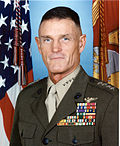 | 15 Jul 1994 | | 2 | 1962 (OCS) | 32 | (1939– ) |
| 28 | John J. Sheehan |  | 31 Oct 1994 | | 3 | 1962 (NROTC) | 32 | (1940– ) |
| 29 | Charles C. Krulak |  | 29 Jun 1995 | | 4 | 1964 (USNA) | 31 | (1942– ) President, Birmingham–Southern College, 2011–2015. Son of Marine Corps lieutenant general Victor H. Krulak. |
| 30 | Richard I. Neal |  | 19 Sep 1996 | | 2 | 1965 (NROTC) | 31 | (1942–2022) |
| 31 | Anthony C. Zinni |  | 8 Aug 1997 | | 3 | 1965 (NROTC) | 32 | (1943– ) U.S. Special Envoy to the Middle East, 2002–2003; U.S. Special Envoy to Qatar, 2017–2019. |
| 32 | Charles E. Wilhelm |  | 25 Sep 1997 | | 3 | 1964 (NROTC) | 33 | (1941– ) |
| 33 | Terrence R. Dake | 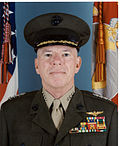 | 5 Sep 1998 | | 2 | 1966 (OCS) | 32 | (1944– ) |
| 34 | James L. Jones |  | 30 Jun 1999 | | 7 | 1967 (NROTC) | 32 | (1943– ) National Security Advisor, 2009–2010. |
| 35 | Peter Pace | 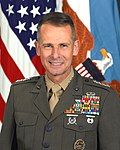 | 8 Sep 2000 | | 7 | 1967 (USNA) | 33 | (1945– ) Awarded Presidential Medal of Freedom, 2008. |
| 36 | Carlton W. Fulford Jr. | 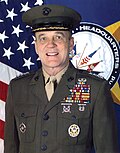 | 1 Oct 2000 | | 2 | 1966 (USNA) | 34 | (1944– ) |
| 37 | Michael J. Williams |  | 1 Nov 2000 | | 2 | 1967 (USNA) | 33 | (1943– ) |
| 38 | William L. Nyland | 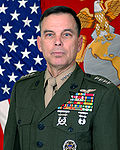 | 4 Sep 2002 | | 3 | 1968 (NROTC) | 34 | (1946– ) |
| 39 | Michael W. Hagee |  | 14 Jan 2003 | | 3 | 1968 (USNA) | 35 | (1944– ) |
| 40 | James E. Cartwright |  | 1 Sep 2004 | | 7 | 1971 (NROTC) | 33 | (1949– ) |
| 41 | Robert Magnus |  | 1 Nov 2005 | | 3 | 1969 (NROTC) | 36 | (1947– ) |
| 42 | James T. Conway |  | 13 Nov 2006 | | 4 | 1970 (OCS) | 36 | (1947– ) |
| 43 | James N. Mattis |  | 9 Nov 2007 | | 6 | 1972 (NROTC) | 35 | (1950– ) U.S. Secretary of Defense, 2017–2019. |
| 44 | James F. Amos | 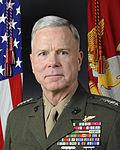 | 2 Jul 2008 | | 6 | 1970 (NROTC) | 38 | (1946– ) First naval aviator to become commandant. |
| 45 | Joseph F. Dunford Jr. |  | 23 Oct 2010 | | 9 | 1977 (OCS) | 33 | (1955– ) |
| 46 | John R. Allen | 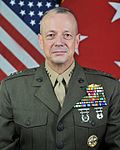 | 18 Jul 2011 | | 2 | 1976 (USNA) | 35 | (1953– ) Special Presidential Envoy for the Global Coalition to Counter the Islamic State of Iraq and the Levant, 2014–2015; President, Brookings Institution, 2017–2022. |
| 47 | John F. Kelly |  | 19 Nov 2012 | | 3 | 1976 (OCS) | 36 | (1950– ) U.S. Secretary of Homeland Security, 2017; White House Chief of Staff, 2017–2019. |
| 48 | John M. Paxton Jr. |  | 15 Dec 2012 | | 4 | 1974 (OCS) | 38 | (1951– ) |
| 49 | Robert B. Neller | 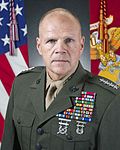 | 24 Sep 2015 | | 4 | 1975 (OCS) | 40 | (1953– ) |
| 50 | Thomas D. Waldhauser |  | 18 Jul 2016 | | 3 | 1976 (OCS) | 40 | (1953– ) |
| 51 | Glenn M. Walters |  | 2 Aug 2016 | | 2 | 1979 (Citadel) | 37 | (1957– ) President, The Citadel, 2018–present. |
| 52 | Gary L. Thomas |  | 4 Oct 2018 | | 3 | 1984 (NROTC) | 34 | (1962– ) |
| 53 | Kenneth F. McKenzie Jr. |  | 28 Mar 2019 | | 3 | 1979 (Citadel) | 40 | (1957– ) |
| 54 | David H. Berger |  | 11 Jul 2019 | | 4 | 1981 (NROTC) | 38 | (1959– ) |
| 55 | Eric M. Smith |  | 8 Oct 2021 | | 4 | 1987 (Texas A&M) | 34 | (c. 1965– ) |
| 56 | Michael E. Langley | 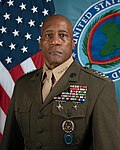 | 6 Aug 2022 | | 3 | 1985 (OCS) | 37 | (c. 1963– ) First African-American to achieve the rank of general in the Marine Corps. |
| 57 | Christopher J. Mahoney |  | 2 Nov 2023 | | 2 | 1987 (NROTC) | 38 | |
| 58 | Bradford J. Gering |  | 2 Oct 2025 | | 0 | 1989 (NROTC) | 36 | |















































































